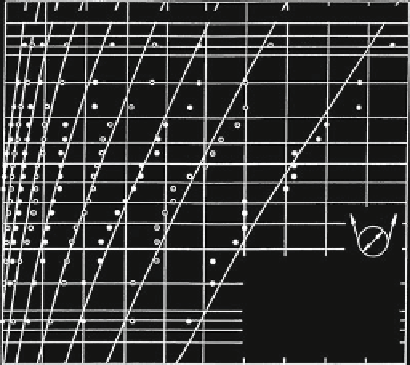Civil Engineering Reference
In-Depth Information
Fig. 3.74 Number of wire
breaks distribution and
Poisson distribution
99
98
95
x10
3
50
80 100
125
160
200
250
N= 320
63
90
80
70
60
50
40
30
20
S=30kN
D
I = 8 x 2 x 22.5 d
Warrington 8 x 19
SFC
−
sZ, bright
d = 16 mm, D/d = 25
steel, r = 0.53 d
lubricated
10
5
2
1
0
5
10
15 20
number of wire breaks B
22.5
25
30
35
40
45
50
According to (
3.82a
), the probable maximum number of wire breaks is
B
L,max
= 11. The probable maximum number of wire breaks can be calculated
with the help of the Excel-program, ''POISSON 2.XLS''.
Figure
3.74
shows the distribution of the wire breaks observed in a bending
fatigue test and the calculated Poisson distribution with (
3.79
) drawn as smooth
curve. This figure shows just how closely the observed number of wire breaks
corresponds to the Poisson distribution close to the end of the rope life.
Very often the Poisson distribution is valid only for the smaller relative number
of bending cycles. An example for this is to be seen in Fig.
3.75
where the
observed numbers of wire breaks already deviate from the Poisson distribution for
the relative number of bending cycles N
0
= 55 %. However these observed
numbers of wire breaks can be explained as a birth-distribution introduced by Ren
(
1996
).
For the birth-distribution, the wire breaks continue to occur by chance but
prefer those sections already weakened by w
ir
e breaks. For the birthdistribution,
Ren (
1996
) defined the variance factorm
¼
V
=
B
L
where the variance is greater than
the mean number of wire breaks V [ B
L
. Remember, m = 1 for the Poisson-
distribution.
The probability w(B
L
) of the birth-distribution that the number of wire breaks
B
L
= 0, 1, 2, 3, etc. exists on the reference length L is according to Ren (
1996
)
B
L
1
v
1
v
B
L
v
v
1
w
ð
B
L
Þ
¼
ð
3
:
77a
Þ
B
L
b
ð
B
L
;
v
1
Þ
B
L
with the Beta-function expressed by the better known Gamma-function C




Search WWH ::

Custom Search